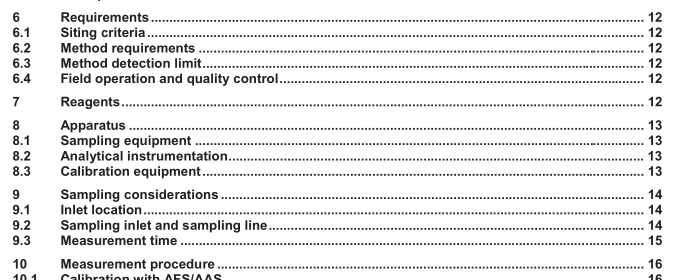EN 15852:2010 – Ambient air quality – Standard method for the determination of total gaseous mercury

6 Requirements
6.1 Siting criteria The siting requirements for TGM measurements are given in Annex A.
6.2 Method requirements The method for the measurement of total gaseous mercury concentrations in ambient air shall be an automated method based on Atomic Absorption Spectrometry or Atomic Fluorescence Spectrometry, as specified in Annex V.III of Directive 2004/107/EC.
6.3 Method detection limit The detection limit of the gold trap analysis method (expressed in nanograms of mercury) shall not exceed 10 % of the lower limit of the working range of the mercury expected to be collected during any measurement period. This will depend on the measurement time and the sampling flow rate. The detection limit of the Zeeman AAS method (expressed in nanograms per cubic metre) shall not exceed 10 % of the lower working range.
6.4 Field operation and quality control After the installation at the monitoring station, the analyser shall be tested to ensure that it is working correctly. It is essential that the expanded uncertainty of measurements in the field does not exceed the 50 % according to Directive 2004/107/EC. Requirements and recommendations for quality assurance and quality control are given for the measurements in the field (see Clause 11).
7 Reagents
7.1 Argon, of purity greater than 99,999 %, suitable for use as a carrier gas for CVAAS and CVAFS.
7.2 Nitrogen, of purity greater than 99,999 %, suitable for use as a carrier gas for CVAAS and CVAFS.
7.3 Air, of class 3.3.3 purity or better according to ISO 8573-1:2010.
7.4 Elemental mercury, of purity 99,999 9 %, for preparation of gaseous mercury vapour standard.
WARNING — Mercury is toxic by skin absorption and inhalation of vapour. Use suitable personal protective equipment (including gloves, face shield or safety glasses, etc.) and minimize exposure by using a fume hood.
7.5 Water, resistivity greater or equal to 18 MΩ·cm at 298 K.
The ultrapure water used in this method is for cleaning purposes only.
7.6 Hydrochloric acid (HCl), concentrated, density ~ 1,18 g/ml, mass fraction 36 % to 38 %.
The concentration of mercury shall be less than 0,002 mg/l.
WARNING — Concentrated hydrochloric acid is corrosive and hydrochloric acid is an irritant. Avoid contact with the skin and eyes, or inhalation of the vapour. Use suitable personal protective equipment (including gloves, face shield or safety glasses, etc.) when working with hydrochloric acid.
EN 15852:2010 – Ambient air quality – Standard method for the determination of total gaseous mercury